秋季课程人教版高二英语选修六unit4 Global warming 教案
- 格式:doc
- 大小:122.00 KB
- 文档页数:13
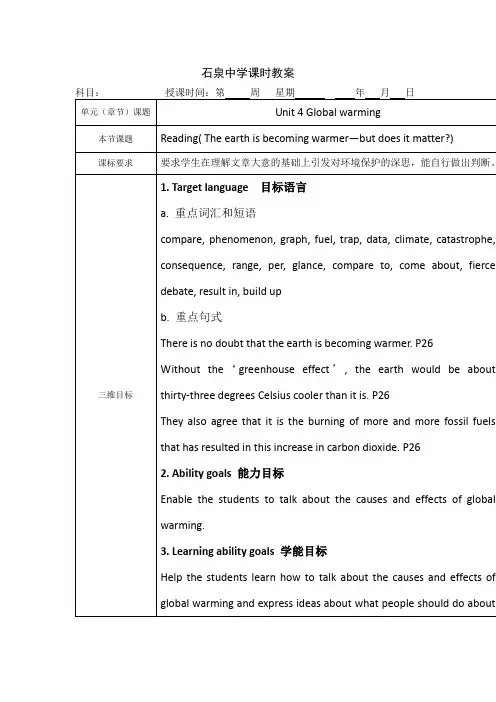
石泉中学课时教案精美句子1、善思则能“从无字句处读书”。
读沙漠,读出了它坦荡豪放的胸怀;读太阳,读出了它普照万物的无私;读春雨,读出了它润物无声的柔情。
读大海,读出了它气势磅礴的豪情。
读石灰,读出了它粉身碎骨不变色的清白。
2、幸福幸福是“临行密密缝,意恐迟迟归”的牵挂;幸福是“春种一粒粟,秋收千颗子”的收获. 幸福是“采菊东篱下,悠然见南山”的闲适;幸福是“奇闻共欣赏,疑义相与析”的愉悦。
幸福是“随风潜入夜,润物细无声”的奉献;幸福是“夜来风雨声,花落知多少”的恬淡。
幸福是“零落成泥碾作尘,只有香如故”的圣洁。
幸福是“壮志饥餐胡虏肉,笑谈渴饮匈奴血”的豪壮。
幸福是“先天下之忧而忧,后天下之乐而乐”的胸怀。
幸福是“人生自古谁无死,留取丹心照汗青”的气节。
3、大自然的语言丰富多彩:从秋叶的飘零中,我们读出了季节的变换;从归雁的行列中,我读出了集体的力量;从冰雪的消融中,我们读出了春天的脚步;从穿石的滴水中,我们读出了坚持的可贵;从蜂蜜的浓香中,我们读出了勤劳的甜美。
4、成功与失败种子,如果害怕埋没,那它永远不能发芽。
鲜花,如果害怕凋谢,那它永远不能开放。
矿石,如果害怕焚烧(熔炉),那它永远不能成钢(炼成金子)。
蜡烛,如果害怕熄灭(燃烧),那它永远不能发光。
航船,如果害怕风浪,那它永远不能到达彼岸。
5、墙角的花,当你孤芳自赏时,天地便小了。
井底的蛙,当你自我欢唱时,视野便窄了。
笼中的鸟,当你安于供养时,自由便没了。
山中的石!当你背靠群峰时,意志就坚了。
水中的萍!当你随波逐流后,根基就没了。
空中的鸟!当你展翅蓝天中,宇宙就大了。
空中的雁!当你离开队伍时,危险就大了。
地下的煤!你燃烧自己后,贡献就大了6、朋友是什么?朋友是快乐日子里的一把吉它,尽情地为你弹奏生活的愉悦;朋友是忧伤日子里的一股春风,轻轻地为你拂去心中的愁云。
朋友是成功道路上的一位良师,热情的将你引向阳光的地带;朋友是失败苦闷中的一盏明灯,默默地为你驱赶心灵的阴霾。
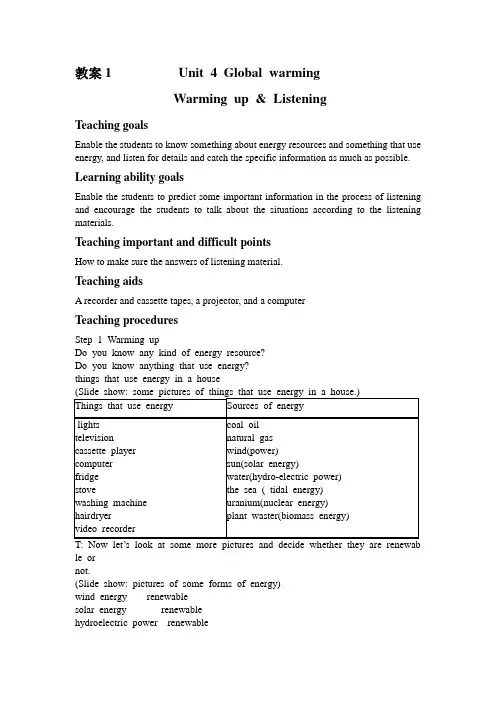
教案1 Unit 4 Global warmingWarming up & ListeningTeaching goalsEnable the students to know something about energy resources and something that use energy, and listen for details and catch the specific information as much as possible. Learning ability goalsEnable the students to predict some important information in the process of listening and encourage the students to talk about the situations according to the listening materials.Teaching important and difficult pointsHow to make sure the answers of listening material.Teaching aidsA recorder and cassette tapes, a projector, and a computerTeaching proceduresStep 1 Warming upDo you know any kind of energy resource?Do you know anything that use energy?things that use energy in a housele ornot.(Slide show: pictures of some forms of energy)wind energy renewablesolar energy renewablehydroelectric power renewablegeothermal energy renewabletidal energy renewablebiomass energy renewablenuclear power plant, non-renewable (picture)an oil refinery(精炼厂), non-renewable (picture)coal power station, non-renewable (picture)natural gas non-renewable (picture)uranium Ore (铀矿石) non-renewable (picture)The element uranium does not occur in pure form in nature but is found in m inerals such as carnotite(钒钾铀矿), pictured above. (picture)Conclusionnon-renewablecoal oil natural gas Uranium fossil fuelsrenewablewind (wind power) sun (solar energy) water (hydro-electric power)plant waste (biomass energy) hot springs or geysers (geothermal energy)the sea (tidal energy)Slide showWhat are fossil fuels?Ancient animal and plant material below the surface of the earth with a high carbon content, such as coal, oil and natural gas, which can be burnt to produ ce energy.Also known as non-renewable energy because once they are used they have go neforever; they cannot be renewed.Step 2 Pre-listeningRead Exercise 1 together:1. Read the statements below and tick the ones you agree with.2. Listen to the tape and answer and decide which statement Professor Chen d oesNOT agree with.1. We'll have to stop using fossil fuels.2. About 90% of the world's energy comes from fossil fuels.3. We can replace fossil fuels with renewable sources of energy.4. Nuclear power is a good source of energy.5. In the future, we'll need new technologies to replace fossil fuels.6. It's the developed countries who are to blame for producing most of the car bondioxide.3. Listen again and tick the phrases that Professor Chen uses to agree or disag reewith Li Bin.Slide showExactly. I’m afraid I di sagree with you.That’s true. I’m afraid not.That’s right. I don’t think so.That’s correct. No way.I agree. I don’t agree.4. Listen for the third time and fill in the blanks.1.Our modern _________ societies depend on the energy we get from___ ______.2.It’s a very ____________ and cheap form of energy.3.Can’t we just ________ fossil fuels with ________ sources of energy li ke sun or wind power?4.However, whatever we do, we have to do it as a ________________.5.The _________ countries are really the ones to ______.Keys:1.industrial; fossil fuels 2. concentrated 3。
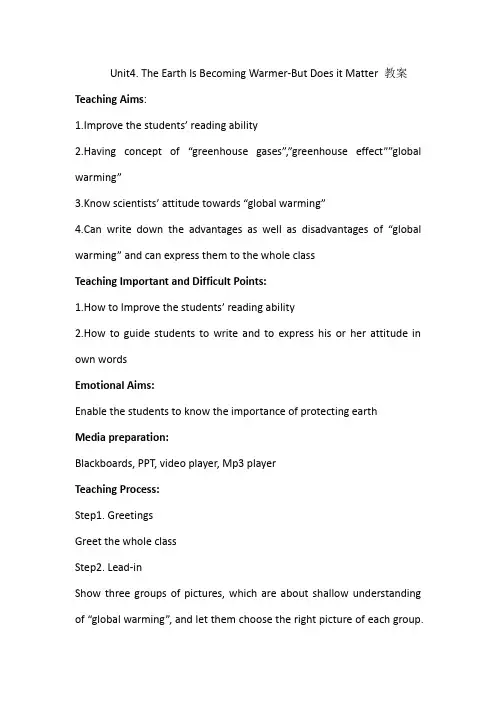
Unit4. The Earth Is Becoming Warmer-But Does it Matter 教案Teaching Aims:1.Improve the students’ reading ability2.Having concept of “greenhouse gases”,”greenhouse effect””global warming”3.Know scientists’ attitude towards “global warming”4.Can write down the advantages as well as disadvantages of “global warming” and can express them to the whole classTeaching Important and Difficult Points:1.How to Improve the students’ reading ability2.How to guide students to write and to express his or her attitude in own wordsEmotional Aims:Enable the students to know the importance of protecting earthMedia preparation:Blackboards, PPT, video player, Mp3 playerTeaching Process:Step1. GreetingsGreet the whole classStep2. Lead-inShow three groups of pictures, which are about shallow understanding of “global warming”, and let them choose the right picture of each group.eg.Which of the following picture doesn’t show the phenomenon?Step3. Fast-ReadingMatch: the main idea of each paragraph. (Divided them into seven groups,each group answer one paragraph.)Step4. Intensive Reading1)Analyze paragraph1 and paragraph2 in a way of graph1. Answer two questions.What is this graph about? What has caused this phenomenon?2) Listen to paragraph3 and then discuss questions in group to choose right answer.Greenhouse gases refer to ____.A. carbon dioxideB. the burning of fossil fuelsC. byproducts of the burning of fossil fuelsD. coal, natural gas and oilGreenhouse effect ____.A. is a natural phenomenonB. happens when there’s too much carbon dioxideC. does great harm to human beingsD. makes life for human beings betterSummarize this paragraph in a way of simple drawing.3)Give a graph2, ask one student to analyze the graph2 as the way of graph1. Then combined with Paragraph4 and Paragraph5, judge T or F. The carbon dioxide content in the air increased by 70 parts per million from 1957 to 1997.All scientists accept the data in graph 2 except Charles Keeling.4)Read paragraph6 together and summarize the different attitudes towards global warming.Dr.Foster: It would lead to a catastrophe.George Hambly: We should not worry about it.5)Read paragraph7 independently and answer questions.If we start reducing the amount of carbon dioxide and other greenhouse gases, is the climate going to stop?What's the attitude of the author? Positive?Negative or Neutral?6)Summarize the structure of the whole passagePart1 (paragraph1)Part2 (Paragraph2-5)Part3 (Paragraph6)Part4 (Paragraph7)Step 5 WritingWrite down the advantage or disadvantage of global warming in your opinion.Step 6 Play a video to express my view.Step7 HomeworkSurf the Internet for more informationabout global warming.Teaching ReflectGlobal Warming is one of the most important topic we face in this century. Teacher should guide students to focus this topic and do activities to protect our earth.。
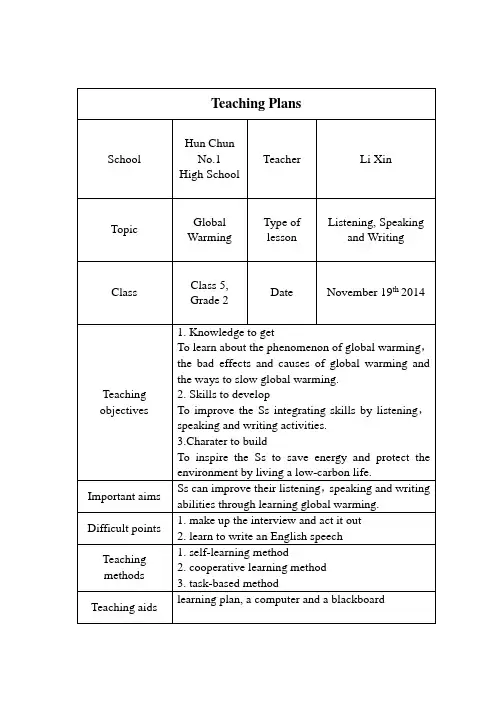

兰州市骨干教师评选教案时间:4月15日地点:兰州新区永登五中高二(4)教室授课教师:桑越茂科目:英语教材:人教版高中英语选修六授课课题:UNIT 4 Using language: Reading and Writing教材分析:1、本单元中心话题是Global warming ,旨在通过本单元教学使学生经过学习认识到全球变暖的起因和它所带来的种种后果,让学生进一步了解地球面临的其它严重问题,帮助学生的树立“节约能源,保护环境”的环保意识,引导学生运用所学语言、句式表达自己对这些现象的看法,培养学生用英语表达自己观点的能力。
2、Reading and Writing部分通过读者和杂志社之间的两封信件,使学生更多地了解作为“地球村”的一员,如何为控制全球变暖做出自己应有的努力。
通过make a poster,write a short passage等不同活动的参与,帮助学生更多地联系自己的生活习惯,树立从自身做起践行环保的观念,这样使课堂的抽象知识变为了社会实践,实现了真正意义上的学以致用。
学情分析:本次教学的实施对象是高二(4)班。
由于学生英语水平参差不齐,学生英语基础薄弱,学生学习英语的困难很大,本节课的教学可以说是一个不小的挑战。
教学理念:坚持“教师为主导,学生为主体,任务为导向”的教学理念;坚持贯彻“教中学,学中用”的实用主义教学理念。
教学方法:学导性教学模式与任务型教学法相结合(基本环节:任务引领——小组合作--交流展示-评价总结)教学目标:1. 知识和技能目标1)知识目标A. 重点词汇和短语: electrical, motor, can (n.), microwave, disagreement, heading, make a difference, put up with, leave an electrical appliance on, so long as等。
B. 重点句式:Together, individuals can make a difference.It takes a lot of energy to make things from new materials. Remember -- your contribution counts‘C.通过学习,让学生更多了解全球变暖现象及成因,以及阻止全球变暖的具体做法。
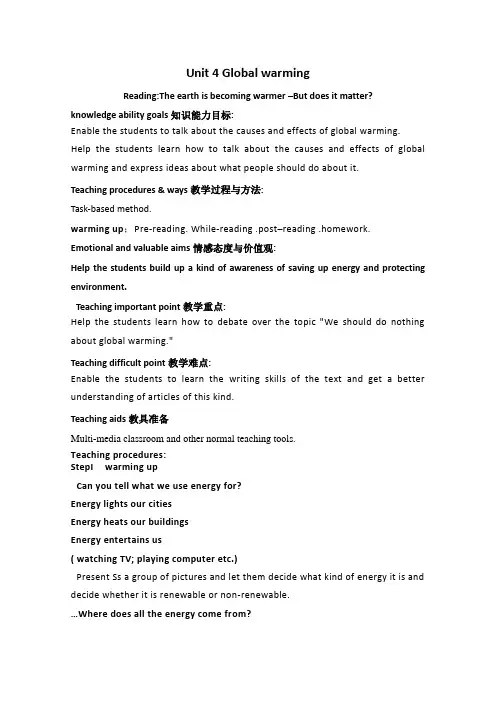
Unit 4 Global warmingReading:The earth is becoming warmer –But does it matter? knowledge ability goals知识能力目标:Enable the students to talk about the causes and effects of global warming. Help the students learn how to talk about the causes and effects of global warming and express ideas about what people should do about it.Teaching procedures & ways教学过程与方法:Task-based method.warming up;Pre-reading. While-reading .post–reading .homework. Emotional and valuable aims情感态度与价值观:Help the students build up a kind of awareness of saving up energy and protecting environment.Teaching important point教学重点:Help the students learn how to debate over the topic "We should do nothing about global warming."Teaching difficult point教学难点:Enable the students to learn the writing skills of the text and get a better understanding of articles of this kind.Teaching aids教具准备Multi-media classroom and other normal teaching tools.Teaching procedures:StepI warming upCan you tell what we use energy for?Energy lights our citiesEnergy heats our buildingsEnergy entertains us( watching TV; playing computer etc.)Present Ss a group of pictures and let them decide what kind of energy it is and decide whether it is renewable or non-renewable.…Where does all the energy come fr om?Picture1 Wind millsPicture2 : a coal power stationPicture3:an oil refinery Picture4:a nuclear power plant Picture5:Solar panels Picture6: a hydro damStep II Pre-reading ;1. Show a picture of greenhouse on the screen, and ask1. What is it in the picture?It ’s a greenhouse made of glass.2. What is it used for?It ’s used for growing plants, especially during cold weather.3. How does it work?The air inside is warm because the glass traps the heat from the sun and keeps it from escaping. This makes the greenhouse heat up and so the plants can grow throughout the cold period.4. What is greenhouse gases?The gases surrounding the earth,including carbon dioxide, methane and water vapor.5. What do you think greenhouse gases do?They trap heat from the sun and therefore warm the earth.Step III While- readingTask 1: skimmingGlance quickly at the magazine article and answer the questions.1. Who wrote the magazine article? What is the name of the magazine?Sophie Armstrong wrote the magazine article. The name of the magazine is Earth Care.2. What are the names of the three scientists mentioned in the article?They are Dr. Janice Foster, Charles Keeling and George Hambley.3…. What is the main topic of the article?Global warming/ the warming of the earth.Task 2:listen andScan the textRead it quickly and try to get the general idea and divide the whole passage into several parts and summarize the main idea.False: 1, 2, 4, 9, 10Correct sentences:1. The temperature last century increased much.2. Not everyone believes that global warming is caused by human activities. 4. Natural gas is not a greenhouse gas but a fossil fuel.9. George Hambley thinks that more carbon dioxide is a positive thing and it will make plants grow faster.10. It is unknown what the effects of global warming will be.Task 3: Group activity .Should we do nothing about global warming?StepⅣPost-reading:1.write a summary.Do not include your own opinion, but be sure to use our own words (about 30words.)(不能添加自己的见解,但是要用自己的语言概括.大约30个词左右)The reading passage is a discussion and puts forward different points of view about the effect of increased carbon dioxide in the atmosphere the causes of theearth’s increased temperature and the possible effects .Ste pIIV.HomeworkRead the passage again and review the new words and expressions.。
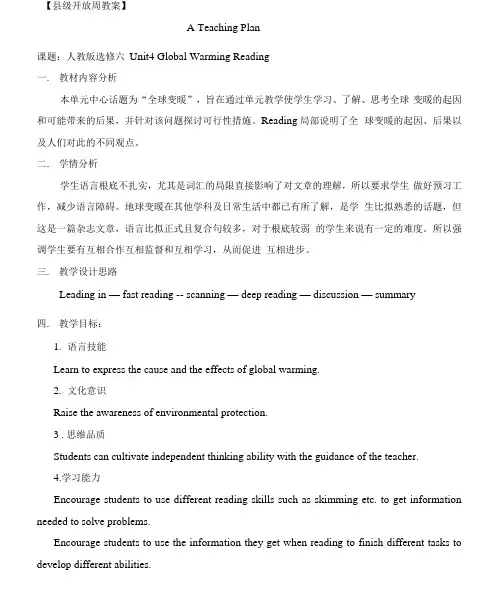
【县级开放周教案】A Teaching Plan课题:人教版选修六Unit4 Global Warming Reading一. 教材内容分析本单元中心话题为“全球变暖”,旨在通过单元教学使学生学习、了解、思考全球变暖的起因和可能带来的后果,并针对该问题探讨可行性措施。
Reading局部说明了全球变暖的起因、后果以及人们对此的不同观点。
二. 学情分析学生语言根底不扎实,尤其是词汇的局限直接影响了对文章的理解,所以要求学生做好预习工作,减少语言障碍。
地球变暖在其他学科及日常生活中都已有所了解,是学生比拟熟悉的话题,但这是一篇杂志文章,语言比拟正式且复合句较多,对于根底较弱的学生来说有一定的难度。
所以强调学生要有互相合作互相监督和互相学习,从而促进互相进步。
三. 教学设计思路Leading in — fast reading -- scanning — deep reading — discussion — summary四. 教学目标:1.语言技能Learn to express the cause and the effects of global warming.2.文化意识Raise the awareness of environmental protection.3 .思维品质Students can cultivate independent thinking ability with the guidance of the teacher.4.学习能力Encourage students to use different reading skills such as skimming etc. to get information needed to solve problems.Encourage students to use the information they get when reading to finish different tasks to develop different abilities.五. 教学重难点重点Help the students learn the cause and effects of global warming.难点How to guide the students to understand global warming better and collect specific details to voice their own views in a critical way.六. 教学方法Task-based Language Teaching Approach七. 教学策略充分利用多媒体辅助教学,发挥信息技术的作用,丰富教学内容,提高学生的学习兴趣和课堂教学效率。

⼈教版⾼中英语选修6精选教案:Unit4GlobalwarmingReading⼈教版选修6 Unit 4 Global warming教案ReadingTeaching goalsTarget languagewords and phrases:energy, light(v.), heat(v.), renewable, non-renewable, run out, compare, phenomenon, graph, fuel, trap, data, climate, catastrophe, consequence, range, per, glance, compare to, come about, fierce debate, result in, build up, keep onAbility goalsEnable the students to talk about different sources of energy.Enable the students to read the text, understand what it is about and talk about the causes and effects of global warming. Teaching important & difficult pointsEnable the students to get a better understanding of articles of this kind.Teaching aidsA projector and a blackboardTeaching proceduresStep 1 Warming upT:Now let's look at a picture on the slide and answer the question below.What is the greenhouse made and used for?A greenhouse is made of glass and is used for growing plants, especially during cold weather. What's greenhouse effect? Step 2 ScanningRead the text quickly and find the answer to the questions:1. Who wrote the magazine article? What is the name of the magazine?Sophie Armstrong, Earth Care.2. What are the names of the three scientists mentioned in the article?Dr Janice Foster, Charles Keeling, George Hambley.3. What do they think about global warming? Do they agree with one another?They don't agree with each other.Dr. Janice Foster thinks the effects of global warming could be very serious.George Hambley thinks global warming will be mild with few bad environmental consequences.Charles Keeling believes it is the burning of more and more fossil fuels that is resulting in a big increase in carbon dioxide. The first graph shows the temperature increase of one degree Fahrenheit between 1860to 2000. The second graph shows the carbon dioxide content in the atmosphere from 1957 to 1977.4. What are the two graphs about?The first graph shows the temperature increase of one degree Fahrenheit between 1860to 2000. The second graph shows the carbon dioxide content in the atmosphere from 1957 to 1977.5. What is the main topic of the article?Global warming/ the warming of the earth.Step 3 SkimmingRead the passage carefully and judge whether the statements are true or false.1. The temperature last century didn't increase much.2. Everyone believes that global warming is caused by the activities of humans.3. Janice Foster believes that global warming is caused b the burning fossil fuels.4. Natural gas is a greenhouse gas.5. Carbon dioxide is a byproduct of burning fossil fuels.6. People accept Charles Keeling's data because he took accurate measurements.7. Flooding could be one of the effects of future global warming.8. George Hambley believes scientists are just guessing about the effects of globalwarming.9. George Hambley is worried about the effects of carbon dioxide on plant growth.10. It is clear what the effects of global warming will be.Keys: True: 3, 5, 6, 7, and 8 False: 1, 2, 4, 9, 10Step 4 Detailed readingRead the text carefully and try to find out how many parts we can divide the text into and find out the main idea of each part. Part (Para_ to Para_ )Main ideaPart 1 (Para _1_)introduce a debate over the issue of global warmingPart 2 (Para _2__ to _4__)illustrate how global warming comes aboutPart 3 (Para _5__ to 10___)list two different attitudes among scientists towards global warmingPart 4 (Para _11__ to ___)It's up to readers to think and decide whether people should do something about global warming or not.Step 5 DebateGet into groups of six. Decide which three in your group are going to agree with the statement and which three are going to disagree with the statement.Group A: We shall do something about global warming.Group B: We shall do nothing about global warming.Group A discuss why they agree with the statement; Group B discuss why they disagree.Group A and B get together. Tell each other the reasons why agree or disagree with the statement. Step 6 Homework1. Read the passage again and review the new words and expressions.2. Prepare the debate in groups.3. Surf the Internet for more information about global warming。
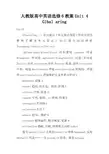
人教版高中英语选修6教案Unit 4Glbal aringUnit4Glbalaring一、语言要点I单元要点预览(旨在让同学整体了解本单元要点)词汇部分词语辨析1nsequene/result/effet/ute2glane/gaze/glare/stare词形变化1agreev同意disagreev不同意agreeent/disagreeentn同意/不同意2existv存在existenen存在3statev陈述,说明stateentn 声明,阐述4envirnentn环境envirnentalad周围的,环境的envirnentalistn环境保护主义者重点单词1phenennn現象2tendvt趋向,往往是;照管,护理3statevt声明,陈述4rangen行列,范围;vt排列,归类于averagead平均的6existenen生存7advate倡导,拥护8refreshv精神振作,精力恢复,更新9ntributinn捐献,贡献,投稿重点词组eabut发生quantitiesf大量的resultin导致beppsedt反对nbehalff代表……一方putupith忍受;容忍slngas只要重点句子1Sebprdutsfthispressarealled “greenhuse”gases,thestiprtantnefhihisarbndixide这个升温过程的一些副产品就叫“温室”气体,其中最重要的就是二氧化碳重点语法it的用法(II)II词语辨析1)nsequene/result/effet/ute【解释】nsequene强调因某事而引起的后果,有时带贬义。
result普通用语,指某行动,计划或事带来的最终结果。
effet与相对,指动作行为带来的后果或效应。
ute侧重某项活动,比赛的结果,结局【练习】选择nsequene/result/effet或ute并用其适当的形式填空1)The________fthegaeasbendurexpetatin2)The_________ ftheeetingasthatnneshuldbedisissed3)Theadvertiseent shaveuh________nnsuers’hie4)In_________flaziness,heasfiredes:1)ute2)result3)effet4)nsequene2)glane/gaze/glare/stare看,注视【解释】glane一瞥,匆匆一看,强调动作的短暂gaze凝视,注视,因惊异或赞赏而长时间无意识地凝视某人或某事物glare怒视,带有敌对或威胁的态度stare盯着看,含有无礼或粗俗的意味。
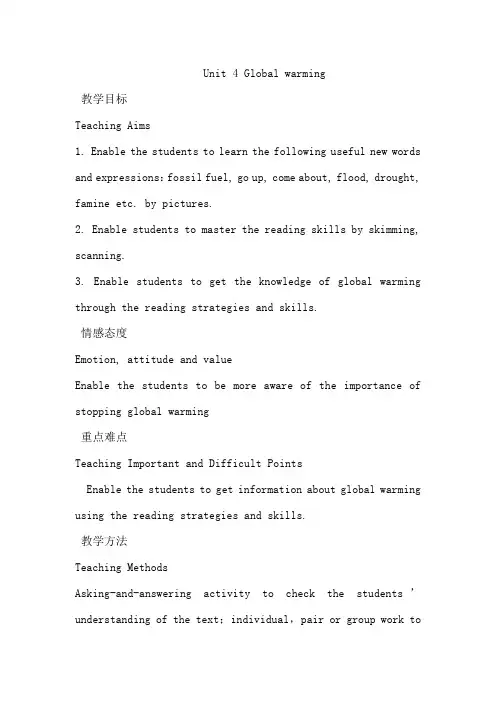
Unit 4 Global warming教学目标Teaching Aims1. Enable the students to learn the following useful new words and expressions:fossil fuel, go up, come about, flood, drought, famine etc. by pictures.2. Enable students to master the reading skills by skimming, scanning.3. Enable students to get the knowledge of global warming through the reading strategies and skills.情感态度Emotion, attitude and valueEnable the students to be more aware of the importance of stopping global warming重点难点Teaching Important and Difficult PointsEnable the students to get information about global warming using the reading strategies and skills.教学方法Teaching MethodsAsking-and-answering activity to check the students’understanding of the text;individual,pair or group work tofinish each task.5教学过程Teaching ProceduresStep 1. Lead-in1) Greetings and lead in.Show a film of The Day After Tomorrow and ask them the following question:What can you see in the film?--hurricane, tsunami, glacier melting .What other disasters do you know?--Flood, drought, famine.What causes the disasters?--It’s the global warming.What causes the the global warming?--Picture1: the burning of fossil fuelsPicture2: greenhouse gases: carbon dioxide, water vapor, methaneAs a result, the earth will become warmer and warmer.Step 2. Skimming:Glance the first paragraph:1. Who wrote the magazine article?A. Janice FosterB. Sophie Armstrong2. What is the topic of the article?A. The earthB. Global warming3. There are the names of the three scientistsin the article EXCEPT______.A. Dr Janice FosterB. Sophie ArmstrongC. Charles KeelingD. George HambleyStep 3. Scanning for detailed information (Group work)Part2(2-5)1. What do the two graphs show?--The first graph shows the temperature increase of one degree Fahrenheit between 1860 to 2000.--The second graph shows carbon dioxide went up from 1957 to 19972. What do you know about greenhouse effect?Greenhouse gases trap(吸收) the heat from the sun and therefore warm the earth.3. Which following is NOT TRUE about global warming? (D)A. The increase of temperature is due of the burning of the fossil fuels.B. The burning of the fossil fuels caused the increase in carbon dioxide.C. All believes that activities of humans have caused globalwarming.D. The attitudes of scientists toward it are the same. The different ideas of the effects of the global warming Part3(6)Step 4. SummaryWhat can we learn from the text? Fill in the bland.A. fossil fuelsB. human activityC.warmerD.differentE. heatEveryone believes that the earth is becoming ______. _______________ has caused this global warming: human produce energy by burning ___________. During this process, Dr. Foster HambleyMore carbon dioxide hasnegative effects: rise of the sea level severe storms, droughts, floods, famines, the spread of diseases,thedisappearance of species. More carbon dioxide is a_positive_ thing,makes crops __produce__more and will encourage __agreat range of animals____.greenhouse gases are produced. Greenhouse gases can trap _____ from the sun and warm the earth which is called “greenhouse effect”.The attitudes of scientists towards global warming are ______. On the one hand, it is a positive thing. On the other hand, if there are too many greenhouse gases, more heat will be trapped, causing global warming.Step 5. After-reading group workWhat should we do to stop global warming?Discussion: Suggestions on global warming:turn off the electrical appliancetalk with family and friends about itrecycle things like bottles, plasticsplant more treesride bike rather than carwords 参考词汇: reduce, carbon dioxide, absorb, environment, plant, electrical appliances, recycleSentences structures 句型:We should ... in order to ...moIt is a good idea to ... because it can ...e.g. We should plant more trees in order to absorb the carbon dioxide .It is a good idea to plant more trees because it can absorb the carbon dioxide .Suggestions about global warmingNowadays, global warming is becoming warmer and warmer. It's time for us to take some actions to deal with it.Firstly, we should ________________________________________ in order to _______________________________________. Secondly, it's a good idea to _______________________________________ because _______________________________________.Finally, why not ______________________ because________________________.Let us save energy and stop the global warming together.Step 6. HomeworkWrite a short passage about the suggestions.精美句子1、善思则能“从无字句处读书”。
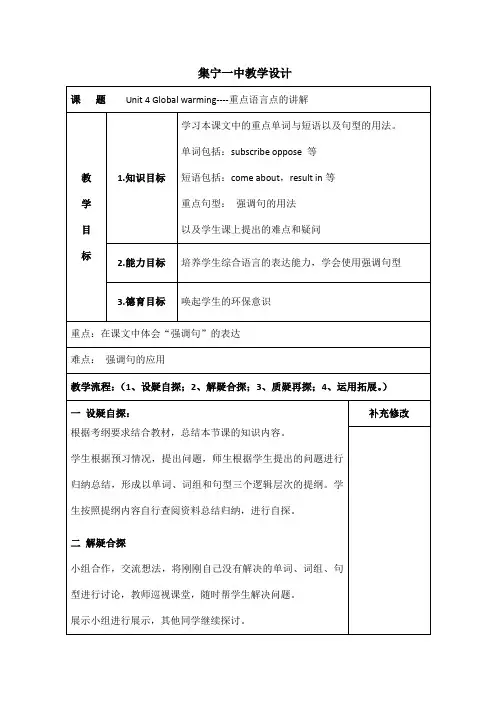
集宁一中教学设计精美句子1、善思则能“从无字句处读书”。
读沙漠,读出了它坦荡豪放的胸怀;读太阳,读出了它普照万物的无私;读春雨,读出了它润物无声的柔情。
读大海,读出了它气势磅礴的豪情。
读石灰,读出了它粉身碎骨不变色的清白。
2、幸福幸福是“临行密密缝,意恐迟迟归”的牵挂;幸福是“春种一粒粟,秋收千颗子”的收获. 幸福是“采菊东篱下,悠然见南山”的闲适;幸福是“奇闻共欣赏,疑义相与析”的愉悦。
幸福是“随风潜入夜,润物细无声”的奉献;幸福是“夜来风雨声,花落知多少”的恬淡。
幸福是“零落成泥碾作尘,只有香如故”的圣洁。
幸福是“壮志饥餐胡虏肉,笑谈渴饮匈奴血”的豪壮。
幸福是“先天下之忧而忧,后天下之乐而乐”的胸怀。
幸福是“人生自古谁无死,留取丹心照汗青”的气节。
3、大自然的语言丰富多彩:从秋叶的飘零中,我们读出了季节的变换;从归雁的行列中,我读出了集体的力量;从冰雪的消融中,我们读出了春天的脚步;从穿石的滴水中,我们读出了坚持的可贵;从蜂蜜的浓香中,我们读出了勤劳的甜美。
4、成功与失败种子,如果害怕埋没,那它永远不能发芽。
鲜花,如果害怕凋谢,那它永远不能开放。
矿石,如果害怕焚烧(熔炉),那它永远不能成钢(炼成金子)。
蜡烛,如果害怕熄灭(燃烧),那它永远不能发光。
航船,如果害怕风浪,那它永远不能到达彼岸。
5、墙角的花,当你孤芳自赏时,天地便小了。
井底的蛙,当你自我欢唱时,视野便窄了。
笼中的鸟,当你安于供养时,自由便没了。
山中的石!当你背靠群峰时,意志就坚了。
水中的萍!当你随波逐流后,根基就没了。
空中的鸟!当你展翅蓝天中,宇宙就大了。
空中的雁!当你离开队伍时,危险就大了。
地下的煤!你燃烧自己后,贡献就大了6、朋友是什么?朋友是快乐日子里的一把吉它,尽情地为你弹奏生活的愉悦;朋友是忧伤日子里的一股春风,轻轻地为你拂去心中的愁云。
朋友是成功道路上的一位良师,热情的将你引向阳光的地带;朋友是失败苦闷中的一盏明灯,默默地为你驱赶心灵的阴霾。
人教版高中英语选修6《Unit 4 Global warming 》教课设计人教版高中英语选修6《 Unit 4 Global warming 》教课设计【一】教课准备教课目的Teaching Aims:In this class Ss will be able to① practice skimming and scanning for information needed like what are the two concerns and what are Earth Cares suggestions.② Master the phrases such as: put up with, so long as, and so on, makea difference, have no effect on , by making sentences or by using theminto the post er.③ bee aware of the serious effects of global warming and the importance of saving energy to be environmentally friendly.④Summarize the points according to their understanding.⑤work together to design a poster by using the suggestions in thearticle.教课重难点Teaching Difficulties:Students may find it hard to add more suggestions about how to save energy in our daily life and to summarize the points according to those suggestions. Students maynot know clear what is a poster and how to design an attractive and persuasive poster in short time.教课过程Teaching Procedure:Step1. Lead-in (inpidual collective work)1.Teacher begins the class by asking: Have you ever seen the movieThe Day After Tomorrow? and then let students enjoy a short movieclip with the following two questions:①What kinds of disasters have you seen in the film?②Can you guess how they came about (happen)?2.introduce the topic:global warming. And then have a further question:①What other disaster will be caused by global warming?【 Designing Purpose 】To arouse students interest by watching the movie clip and educe thetopic, that is global warming. And then by showing a lot of pictures,make students know and understand the terrible effects of global warming, thus making preparations for promoting environmental protection.① who is the writer?② what are his two concerns?Scanning: Read the second letter and answer the following questions:①Does Earth Care agree with Ouy ang Guangs opinion thatinpiduals can have no effect?②what are Earth Cares suggestions?③Can we carry those suggestions out? Why?【Designing Purpose 】To help the students grasp the main information of the two letters by skimming and scanning. While stud ents get the answer to question1,ask them to find the supporting sentence : Together, inpiduals can makea difference. We do not have to put up with pollution. Guess themeanings of the two italicized phrases according to the surroundings andtheir understanding.Step3. Post reading (Pair work)1.Discussion: Make students discuss whether they can find moreways or suggestions about reducing carbon dioxide and saving energy inour daily life.Suggested ways:1)Use less hot water 7)Change a light bulb 8)Try car sharing2)Take a shower instead of a bath3)Buy fresh food instead of frozen4)Buy things that are actually in season5)Eat less high fat food like KFC and Macdonald6)Clean filters(过滤器) on your air conditioner.【Designing Purpose 】To cultivate students to work in pairs and learn to summarize an opinion and share the knowledge of saving energy in daily life. To practice theability of understanding the meaning of new words and expressionsto remove the obstacles in reading.Step4. learn what is a poster (collective work)Know what is a poster by giving a simple sample and try to getthe structure.【Designing Purpose 】To know clearly a poster should have a heading, contents and an eye-catching slogan, which will make it easy for students to design anacceptable poster.Step5. Prepare the poster (inpidual group work)1. Decide our content s:①Choose and decide five most important suggestions. (inpidual work)②W rite them downon your paper and try to makethem persuasive by using imperativesentences. (inpidual work)③pare your list with your group membersand decide five for your poster. (groupwork)2. Slogan and heading: showing sample posters to help them decide aheading and a slogan for your poster.【Designing Purpose 】This is the most important part of this writing task. Students willbe able to summarize and pose sentences by choosing and organizingwhat they want to say, thus improving their writing ability and the processof output based on what they have learned in reading part. And by learning some sample posters to help them decide their own heading and slogan.Step6. produce show time (group work)With the heading, slogan and ways, students will not find it difficultto make a poster. What theyShould pay attention is how to illustrate their poster and makeit more attractive. And then choose several pairs to represent their posters.【Designing Purpose 】Making the poster will improve their cognitive capability of theimportance of environmental protection and at the sametime they can enjoya sense of achievement in show time. And they make believe that inpiduals can really make a difference.课后习题Homework :Put their poster up around the school to make more students know about energy saving and global warming. Write a short passage to tell othershow to solve the problem of global warming based on the suggestionsyou have collected and send it in your zone or blog.板书板书设计: tsunami/ flood/More suggestions: make full use of paper/ use both sides ofpaper reuse waterlimit the time of using private carssend emails instead of cardsuse less hot wateralways take a shopping bag with youdrive a bicycle but not e-bicycle人教版高中英语选修6《Unit 4 Global warming 》教课设计【二】教课准备教课目的Teaching goals教课目的1. Target language目口号言a.要点词汇和短语energy, light (v.), heat (v.), renewable, non-renewable, fuel, blame, run outb.社交用语I dont think so.I dont think thats right.Im afraid you are wrong.2. Ability goals 能力目标Enable the students to talk about different sources of energy andexpress their own ideas.3. Learning ability goals 学能目标Help the students learn how to give their ideas about the use of energy.教课重难点Teaching important points 教课要点Enable the students to express agreement and disagreement.Teaching difficult points 教课难点Enable the students to learn how to express agreement and disagreement.教课过程Step ⅠRevisionT:Good morning, everyone.Ss: Good morning, teacher.T: Sit down, please. Before class, Ill check your homeworkfirst.Mary, would you read your homework to us?Check the students homework and have a discussion with the studentsabout the mistakes Mary made. Let the students have a clear understanding about the mistakes and then correct them.Step ⅡWarming upT: As we all know,we depen d on energy to do many things in our daily life. Some people even say we could do nothing without energy. Can youtell me what we use energy for?Sa: Energy lights our cities.Sb: Energy heats our buildings.Sc: Energy entertains us. With the help of electricity, people havegot a lot of fun from watching TV, playing puters and so on.Sd: There are many other electrical appliances that make our life more convenient and fortable such as washing machines, microwaves,air conditioners and so on.Se: Today energy also helps people realize many so-called dreams inthe past. For example, people can fly from one place to another by planewhich runs on energy.Sf:Its true. In fact, not only planes but also cars, ships and trains run on energy.T:Well done. All that youve just said is right. So it seems that energy plays a very important role in the modern world. Then where does all theenergy e from? Open your books and turn to page 25. Look at thepictures on this page. They may help you find out the answers.After a while.T:Whod like to tell us your answers?Sg: Wind power.Sh: Coal power.T:Right. Is there any difference between them?Si: Yes. Wind will never run out while coal is a limited source.T:Its true. As we know, an energy source is renewable when suppliesof it never run out while some supplies,such as coal, will definitelyrun out one day. Energy of this kind is called non-renewable sources.Please think of as many sources as you can and decide which energy sourceson your list are renewable and which are non-renewable.If necessary, give some words related to the pictures which might bedifficult for the students such as oil refinery,hydroelectric power and so on.The teacher should also collect as much information about differentsources of energy as possible and show it to the students in class through a puter. In this way, the students will bee more interested in this topic and their knowledge on this aspect will be enlarged.T: Fromwhat weve just talked about, it is clear that energy does a lot of good to every coin has two sides. Is there any negative effect of using energy?Sa: use too much energy which is resulting in an increase in carbonis how the global warming es about.Sb: Andmeanwhile it pollutes the environment.T: Itstrue. Many people have realized the problem. Next well do some listeningpractice on this topic. Lets see what other people think of this issue.Thestudents are asked to read the questions quickly to find out the listeningpoints first.Then listen to the tape twice and give the correct answers.T: Nowplease turn to page 31. Lets do listening. Before you listen to the tape,please read fast the statements in Exercise 1 to find out thelistening much attention to the key points while listening.Play thetape for the first time. Help the students get a generalunderstanding aboutthe dialogue. The students listen and try to finishExercise 1. Play the tapeagain, train the students ability to spot specific information and understandthe implication in the dialogue.The students listen and finish Exercise 2.Severalminutes later.T:Have you finished the exercises?Ss: Yes.T: OK,lets check your answers.Explainsome difficult points if necessary.T: Nowread what Professor Chen and Li Bin say. Work in groups. Discuss who you agreewith and give reasons. Use some of the phrases listed in Exercise 2 or anyothers you know.课后习题Homework1.Review the new words and expressions you learned in this class.2.Preview Reading.。
教学设计高二年级英语导学案品味人生1、不管鸟的翅膀多么完美,如果不凭借空气,鸟就永远飞不到高空。
想象力是翅膀,客观实际是空气,只有两方面紧密结合,才能取得显着成绩。
2、想停下来深情地沉湎一番,怎奈行驶的船却没有铁锚;想回过头去重温旧梦,怎奈身后早已没有了归途。
因为时间的钟摆一刻也不曾停顿过,所以生命便赋予我们将在汹涌的大潮之中不停地颠簸。
3、真正痛苦的人,却在笑脸的背后,流着别人无法知道的眼泪,生活中我们笑得比谁都开心,可是当所有的人潮散去的时候,我们比谁都落寂。
4、温暖是飘飘洒洒的春雨;温暖是写在脸上的笑影;温暖是义无反顾的响应;温暖是一丝不苟的配合。
5、幸福,是一种人生的感悟,一种个人的体验。
也许,幸福是你风尘仆仆走进家门时亲切的笑脸;也许,幸福是你卧病床上百无聊赖时温馨的问候;也许,幸福是你屡遭挫折心灰意冷时劝慰的话语;也许,幸福是你历经艰辛获得成功时赞赏的掌声。
关键的是,你要有一副热爱生活的心肠,要有一个积极奋进的目标,要有一种矢志不渝的追求。
这样,你才能感受到幸福。
6、母爱是迷惘时苦口婆心的规劝;母爱是远行时一声殷切的叮咛;母爱是孤苦无助时慈祥的微笑。
7、淡淡素笺,浓浓墨韵,典雅的文字,浸染尘世情怀;悠悠岁月,袅袅茶香,别致的杯盏,盛满诗样芳华;云淡风轻,捧茗品文,灵动的音符,吟唱温馨暖语;春花秋月,红尘阡陌,放飞的思绪,漫过四季如歌。
读一段美文,品一盏香茗,听一曲琴音,拾一抹心情。
8、尘缘飞花,人去楼空,梦里花落为谁痛?顾眸流盼,几许痴缠。
把自己揉入了轮回里,忆起,在曾相逢的梦里;别离,在泪眼迷朦的花落间;心碎,在指尖的苍白中;淡落,在亘古的残梦中。
在夜莺凄凉的叹息里,让片片细腻的柔情,哽咽失语在暗夜的诗句里。
9、用不朽的“人”字支撑起来的美好风景,既有“虽体解吾犹未变兮”的执着吟哦,也有“我辈岂是蓬蒿人”的跌宕胸怀;既有“我以我血荐轩辕”的崇高追求,也有“敢教日月换新天”的豪放气魄。
人教版,选修6 Unit 4 Global Warming(Reading)教学设计THE EARTH IS BECOMING WARMER—DOES IT MATTER教学分析教学设计说明1、学习者分析学习动向:有强烈的求知欲和学习动机。
对全球变暖现象有着强烈的好奇和了解欲望。
语言水平:对知识的记忆和理解不存在问题,有较好地运用英语进行分析问题的能力,对自己的学习行为能作出较客观地评价。
学习风格:性格差异,学习风格各不相同,但都有自主、合作、探究的学习意识和能力,对学习行为具备一定的自我监控能力。
2、策略设计(1)有效的利用多媒体课件辅助课堂教学活动,丰富教学内容,提高学生学习兴趣和课堂教学效率,充分体现现代化教学技术的优点。
(2)通过教师与同学等人力资源及图书馆、网络等非人力资源查找有关全球变暖的资料,从而开拓视野,形成开放的文化态度。
3、教学方法设计:主要采用任务型教学法、学生中心教学法和多媒体教学法。
学生强烈的好奇心,在可操作的真实有效任务的驱动下,让学生在任务完成过程中充分认识到人类在生存过程中如何科学地改造自然来减少对全球变暖的影响及体验合作学习的成就感。
4、教学设备:多媒体设备课堂教学过程精美句子1、善思则能“从无字句处读书”。
读沙漠,读出了它坦荡豪放的胸怀;读太阳,读出了它普照万物的无私;读春雨,读出了它润物无声的柔情。
读大海,读出了它气势磅礴的豪情。
读石灰,读出了它粉身碎骨不变色的清白。
2、幸福幸福是“临行密密缝,意恐迟迟归”的牵挂;幸福是“春种一粒粟,秋收千颗子”的收获. 幸福是“采菊东篱下,悠然见南山”的闲适;幸福是“奇闻共欣赏,疑义相与析”的愉悦。
幸福是“随风潜入夜,润物细无声”的奉献;幸福是“夜来风雨声,花落知多少”的恬淡。
幸福是“零落成泥碾作尘,只有香如故”的圣洁。
幸福是“壮志饥餐胡虏肉,笑谈渴饮匈奴血”的豪壮。
幸福是“先天下之忧而忧,后天下之乐而乐”的胸怀。
幸福是“人生自古谁无死,留取丹心照汗青”的气节。